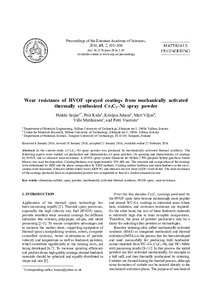Cold Sprayed SLIPS Coatings: A pathway towards process optimization and icephobicity
Maly, Yahya (2020)
Maly, Yahya
2020
Degree Programme in Materials Science and Engineering, MSc (Tech)
Tekniikan ja luonnontieteiden tiedekunta - Faculty of Engineering and Natural Sciences
This publication is copyrighted. You may download, display and print it for Your own personal use. Commercial use is prohibited.
Hyväksymispäivämäärä
2020-06-02
Julkaisun pysyvä osoite on
https://urn.fi/URN:NBN:fi:tuni-202005285764
https://urn.fi/URN:NBN:fi:tuni-202005285764
Tiivistelmä
Ice accretion is a major problem that causes economic loss, damages structure, impedes transports, and potentially leads to human injury and death. There is a strong demand for a reliable passive anti-icing system to reduce and prevent ice adhesion, especially in aircraft applications where ice accretion can change the aerodynamic behaviour and lead to loss of control. Although de-icing and active anti-icing methods exist, passive anti-icing systems are desired because they do not rely on complicated infrastructure and do not require externally supplied energy. It has been established that SLIPS, short for Slippery Liquid-Infused Porous Surfaces, inhibit high water resistance properties, however the connection between the wetting properties (hydrophobicity) and icephobic behavior is under debate. During this study, the feasibility of producing SLIPS via cold spray is studied through multiple randomized experiments aimed at evaluating different spraying parameters and techniques for process development. The study is conducted using various polymer powders and different spraying material. The purpose of these experiments is to produce a functional porous coating that it capable of a lubricant liquid infusion. The process used to produce the polymer-based cold sprayed SLIPS was detailed in this paper. In total, 34 substrates were cold sprayed with polymer-based powders using low-pressure and high-pressure cold spray guns. Eight samples were selected to undergo lubricant infusion and further testing. The coating structures were visually analysed with a microscope. The wettability was estimated by measuring water contact angle. Roughness data and surface topographies were obtained via a profilometer. Lubricant stability of the oil-infused structures was evaluated via centrifuge testing. The results showed that the production of polymer-based cold sprayed SLIPS is feasible. Furthermore, the cold spraying process aids with the production of SLIPS due to partial melting of the polymer particles upon impact with the substrate, resulting in a porous structure. The result further showed that cold sprayed SLIPS have excellent oil stability and do not require complicated surface preparation, which is advantageous over other SLIPS design methods. This thesis work focused on the development of coatings for potential use as icephobic products (i.e. passive anti-icing systems). A deeper investigation into icephobics found that since 1930’s, the development of icephobic products has been hindered by the lack of understanding of ice accretion, unknown meaningful testing methods for new products, debated connection to hydrophobicity, unreliability of icing wind tunnel testing and lack of a standardized method, large scatters of ice adhesion data, discrepancies in literature and different conclusions on the affecting mechanisms, experimental biases, and a general lack of understanding for properties. Although there exist a few icephobic products on the market, their effectiveness is in question by research. The results showed that non-infused samples show greater water contact angle yet, comparison of the real wetting behaviour relies on interpreting the apparent contact angle of three interfacial tensions. Additionally, since the wetting behaviour does not directly imply icephobicity, the author of this study could not conclude that the produced coatings are icephobic, but nevertheless recommended additional testing of polymer-based cold sprayed SLIPS in future studies.
Kokoelmat
Samankaltainen aineisto
Näytetään aineisto, joilla on samankaltaisia nimekkeitä, tekijöitä tai asiasanoja.
-
Protective Spinel Coatings for Solid Oxide Fuel Cell Interconnectors by Thermal Spray Processes: From Conventional Dry Powder to Novel Solution Precursor Thermal Spraying
Puranen, Jouni
Tampere University of Technology. Publication : 1322 (Tampere University of Technology, 2015)
ArtikkeliväitöskirjaProtective coatings are used on ferritic stainless steel interconnectors to prevent the transport of the harmful CrO3(g) and CrO2(OH)2(g) compounds in solid oxide fuel cells. These compounds are transported on the triple-phase ... -
Characteristics of Iron-based Thermal Sprayed Coatings Manufactured with High Velocity Oxygen Fuel and High Velocity Air Fuel Spraying for Wear and Corrosion Applications
Milanti, Andrea
Tampere University of Technology. Publication : 1400 (Tampere University of Technology, 2016)
Artikkeliväitöskirja -
Wear resistance of HVOF sprayed coatings from mechanically activated thermally synthesized Cr3C2–Ni spray powder
Sarjas, Heikki; Kulu, Priit; Juhani, Kristjan; Viljus, Mart; Matikainen, Ville; Vuoristo, Petri (22.02.2016)
articleIn the current study a Cr3C2–Ni spray powder was produced by mechanically activated thermal synthesis. The following aspects were studied: (a) production and characteristics of spray powders, (b) spraying and characteristics ...


